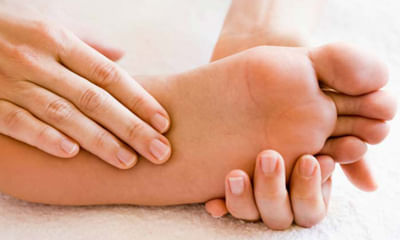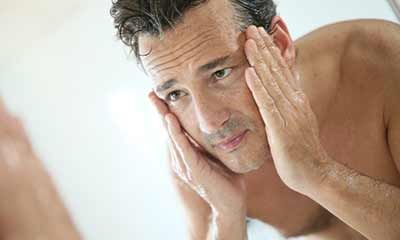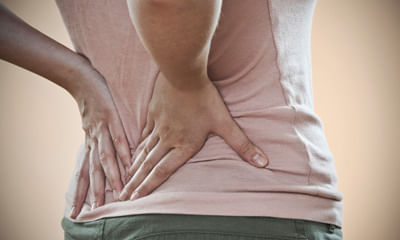Problems With Gabapentin
Hello I am 24 year I have numbness and tingling sensation in my left side thigh this problem facing last six months afte ...
Ask Free Question
Report check and summary. Satya kishor sharma hello I have some report I want to you check and give me information about report. Hello! i'll do my best to help you. What kind of report do you have? Can you give me more details about it? Satya kishor sharma hello I am 24 year I have numbness and tingling sensation in my left side thigh this problem facing last six months after my pregnancy delivery once I visited neurologist he recommended me mri and prescribed medicine tab duloxetine 30 mg and tab methylcobalamin+gabapentin (500/300 mg) but still I have no improvement in my problem please suggest effective treatment. Based on the symptoms you have described, it's possible that you are experiencing a condition called meralgia paresthetica, which is a type of nerve compression syndrome that affects the lateral femoral cutaneous nerve in the thigh. The medication prescribed to you by the neurologist, duloxetine and methylcobalamin+gabapentin, are commonly used to treat nerve pain and may help alleviate some of your symptoms. However, it's important to note that it may take several weeks for these medications to take effect. In addition to medication, there are some other treatments that may help relieve your symptoms: physical therapy: working with a physical therapist can help to stretch and strengthen the muscles surrounding the affected nerve, which can help to reduce pressure on the nerve and alleviate symptoms. Nerve blocks: a nerve block involves injecting a local anesthetic directly into the affected nerve to temporarily block the pain signals. Surgery: in rare cases, surgery may be necessary to relieve pressure on the affected nerve. It's important to follow up with your neurologist and discuss these treatment options to determine the best course of action for you. Additionally, it may be helpful to discuss any lifestyle changes that may be contributing to your symptoms, such as sitting for prolonged periods of time or wearing tight clothing. Get mri done and take further opinion from doctor.
Hello doctor, i've noticed these blisters are growing slowly and new blisters are also growing. I don't know what is the ...
Ask Free Question
Report check and summary. Satya kishor sharma hello I have some report I want to you check and give me information about report. Hello! i'll do my best to help you. What kind of report do you have? Can you give me more details about it? Satya kishor sharma hello I am 24 year I have numbness and tingling sensation in my left side thigh this problem facing last six months after my pregnancy delivery once I visited neurologist he recommended me mri and prescribed medicine tab duloxetine 30 mg and tab methylcobalamin+gabapentin (500/300 mg) but still I have no improvement in my problem please suggest effective treatment. Based on the symptoms you have described, it's possible that you are experiencing a condition called meralgia paresthetica, which is a type of nerve compression syndrome that affects the lateral femoral cutaneous nerve in the thigh. The medication prescribed to you by the neurologist, duloxetine and methylcobalamin+gabapentin, are commonly used to treat nerve pain and may help alleviate some of your symptoms. However, it's important to note that it may take several weeks for these medications to take effect. In addition to medication, there are some other treatments that may help relieve your symptoms: physical therapy: working with a physical therapist can help to stretch and strengthen the muscles surrounding the affected nerve, which can help to reduce pressure on the nerve and alleviate symptoms. Nerve blocks: a nerve block involves injecting a local anesthetic directly into the affected nerve to temporarily block the pain signals. Surgery: in rare cases, surgery may be necessary to relieve pressure on the affected nerve. It's important to follow up with your neurologist and discuss these treatment options to determine the best course of action for you. Additionally, it may be helpful to discuss any lifestyle changes that may be contributing to your symptoms, such as sitting for prolonged periods of time or wearing tight clothing. Satya kishor sharma hello doctor, i've noticed these blisters are growing slowly and new blisters are also growing. I don't know what is the exact problem and cause for this. Please guide me through this. I'm sorry to hear that you're experiencing blisters that are growing and spreading. There are many potential causes of blisters, so it's important to have a healthcare provider examine them to determine the underlying cause and recommend appropriate treatment. Measures to help prevent further irritation or friction on the affected area, such as using cushioned insoles in shoes or wearing gloves.
From 4-5 year I have 24 hour full body pain and fatigue and all tests are normal. 4-5 months ago aiims doctor diagnosed ...
Ask Free Question
Also called: fibrositis self-carephysical exercise aerobic activity for 20–30 minutes 5 days a week improves cardiovascular health. If injured, pursuing an activity that avoids the injured muscle group or joint can help maintain physical function while recovering. Stress management pursuing an enjoyable activity or verbalising frustration to reduce stress and improve mental health. Relaxation techniques deep breathing, meditation, yoga, rhythmic exercise and other activities that reduce symptoms of stress hydrotherapy using water to relieve pain, treat diseases and maintain health. For example, mineral baths and hot tubs. Stretching stretching exercises can improve flexibility and improve physical function. Graded exercise therapy physical exercise that starts very slowly and gradually increases over time. Massage relaxes tense muscles. Heat therapy using heat is an excellent way to help relax muscles and encourage blood flow to areas that are particularly painful. This can easily be done at home using dry or damp hot towels. Simply hold the towel against the affected area until you feel relief. Ultrasound an ultrasound uses sound waves to produce heat which improves blood flow to deep muscle tissue. It can be used to relieve pain, stiffness, spasms, and inflammation widespread muscle pain and tenderness. Symptoms requires a medical diagnosis widespread muscle pain and tenderness are the most common symptoms. People may experience: pain areas: in the muscles, abdomen, back, or neck pain types: can be chronic, diffuse, sharp, or severe pain circumstances: can occur at night gastrointestinal: constipation, nausea, or passing excessive amounts of gas whole body: fatigue, feeling tired, or malaise muscular: muscle tenderness, delayed onset muscle soreness, or muscle spasms sensory: pins and needles, sensitivity to cold, or sensitivity to pain mood: anxiety, mood swings, or nervousness sleep: difficulty falling asleep or sleep disturbances cognitive: forgetfulness or lack of concentration hand: sensation of coldness or tingling also common: depression, flare, headache, irritability, joint stiffness, painful menstruation, or tingling feet treatment consists of self care and therapy medication, talk therapy and stress reduction may help in controlling the symptoms. Self-carephysical exercise aerobic activity for 20–30 minutes 5 days a week improves cardiovascular health. If injured, pursuing an activity that avoids the injured muscle group or joint can help maintain physical function while recovering. Stress management pursuing an enjoyable activity or verbalising frustration to reduce stress and improve mental health. Relaxation techniques deep breathing, meditation, yoga, rhythmic exercise and other activities that reduce symptoms of stress therapies support group a forum for counseling and sharing experiences among people with a similar condition or goal, such as depression or weight loss. Biofeedback controlling the body's heartbeat, brainwaves, breathing and blood pressure by monitoring them with sensors. Cognitive behavioral therapy a talk therapy focused on modifying negative thoughts, behaviours and emotional responses associated with psychological distress. Hydrotherapy using water to relieve pain, treat diseases and maintain health. For example, mineral baths and hot tubs. Chiropractic treatment techniques adjusting the spine and massaging the back muscles to relieve pain. Stretching stretching exercises can improve flexibility and improve physical function. Graded exercise therapy physical exercise that starts very slowly and gradually increases over time. Massage relaxes tense muscles. Acupuncture insertion of needles into specific points on the body to relieve pain and treat other conditions. A form of traditional chinese medicine. Medications selective serotonin reuptake inhibitor (ssri) eases symptoms of depressed mood and anxiety. Analgesic relieves pain. Nonsteroidal anti-inflammatory drug relieves pain, decreases inflammation and reduces fever. Nerve pain medication blocks pain caused by damaged nerves. Muscle relaxant reduces muscle tension and helps relieve muscle pain and discomfort. Fibromyalgia medications can help reduce the pain of fibromyalgia and improve sleep. Common choices include: •pain relievers. Over-the-counter pain relievers such as acetaminophen (tylenol, others), ibuprofen (advil, motrin ib, others) or naproxen sodium (aleve, others) may be helpful. Your doctor might suggest a prescription pain reliever such as tramadol (ultram). Narcotics are not advised, because they can lead to dependence and may even worsen the pain over time. •antidepressants. Duloxetine (cymbalta) and milnacipran (savella) may help ease the pain and fatigue associated with fibromyalgia. Your doctor may prescribe amitriptyline or the muscle relaxant cyclobenzaprine to help promote sleep. •anti-seizure drugs. Medications designed to treat epilepsy are often useful in reducing certain types of pain. Gabapentin (neurontin) is sometimes helpful in reducing fibromyalgia symptoms, while pregabalin (lyrica) was the first drug approved by the food and drug administration to treat fibromyalgia. Therapy a variety of different therapies can help reduce the effect that fibromyalgia has on your body and your life. Examples include: •physical therapy. A physical therapist can teach you exercises that will improve your strength, flexibility and stamina. Water-based exercises might be particularly helpful. •occupational therapy. An occupational therapist can help you make adjustments to your work area or the way you perform certain tasks that will cause less stress on your body.
Diabetic peripheral neuropathic burning feet .how to cure it .although talking medicine 1200 mg gabapentin nt 20 mg but ...
Ask Free Question
Hello, thanks for the query. I have seen the details mentioned. The symptoms of peripheral neuropathy like burning pain or irritation, those can be effectively controlled by using certain medications like gabapentine, pragabalin & methylcobalamineetc. But it is difficult to "cure" those. The reason is those are part of the long term complications of diabetes mellitus. Neuropathy tends to be more severe and repetitive if blood glucose is not in proper control. I am sure you are aware at your age ideally fbg should be just around 100 mg & pp glucose should be 150 170 mg, plus hba1c% has to be < 7%. Since there is no information on those, it is difficult to know how good is your blood glucose control. The medications being used are good enough, but strict glucose control is also more important. Thanks.
My anxiety medicine are valprol cr300 paroxetine 12.5 mirtaz15 and alprazolam 0.25 mg and gabapentin nt 400 thyroxine 10 ...
Ask Free Question
Hello Mr. lybrate-user these medications do not have any significant interactions and can be taken together hope this helps.
I have been suffering from lumber canal spinal stenosis from last 2 years. I feel pain in my right leg when walk or stan ...
Ask Free Question
I need to see the mri report first. If the diagnosis is spinal canal stenosis then it won't vanish or decrease without any treatment. U may need some form of intra spinal injections, posture correction, supportive lumbar care etc.
My mother ambika nair is diabetic for over 35 years. Her sugar levels are in control. The recent test was 107 fasting an ...
Ask Free Question
Sorry to know that your mother is in pain, burning sensation could be due to diabetes ,rapid correction of blood sugars or kidney related issues. Please check her body weight, blood pressure and serum creatinine. Muscle pain could be a part of neuropathy and if there is stiffness relaxants like baclofen or tizanidine could help. Non opioid pain medication like tramadol which is safe in diabetes could be added to paracetamol. Burning sensation may respond to medications like gabapentin, carbazepinr, amitriptyline etc. Please consult a doctor who takes a good history and physical exam and treat accordingly. Thanks.
Hi, I have been taking clonazepam 0.25 twice daily since 3 years for anxiety issues. I now want to get over with it, man ...
Ask Free Question
No sir, it is not at all adviseable to try this medication nor to self-medicate/regulate without doctor's approval. If you are so keen on coming off of this medication and want to improve your health, I suggest that you go for counseling in tandem with he medicines. If you combined counseling with the medication you can expect the best outcomes for your anxiety disorder. However, you must be episode-free for at least three years before the doctor will decide on weaning you off of the medication but in a gradual and effective manner. Counseling will help in training you will skills and techniques to cope with the daily challenges in life and will give you a fair chance to manage your life when the reduction in medicines is initiated by the doctor. You must also develop your constitution to make it fit enough to cope with fear, felt many times unnecessarily. This involves physical fitness through exercise, good rest (sleep), and a proper diet. Mental stability can be achieved by learning a few skills in handling emotions in an appropriate manner. Stress management skills, which have a lot to do with expressing emotions, will need to be a major part of your recovery program. Please persevere and cooperate through all the support.
My father is diabetic and has neuropathy issue and uses to stick to walk outside home, so left leg has less sensation. I ...
Ask Free Question
Prevention of neuropathy: 1. Avoid alcohol consumption and cigarette smoking. 2. Maintain ideal body weight/bmi (body mass index) 3. Lifestyle changes: daily exercises (>30 minutes per day) or brisk walking or swimming; avoid prolonged sitting or standing (>30 minutes). 4. Food/diet should have following components: •green vegetables e.g. Spinach, fenugreek leaves (methi), radish, etc •coloured vegetables e.g. Tomato, carrot, capsicum (green/red), ladies-finger (bhindi) •milk products e.g. Milk, buttermilk, curd, cheese (paneer) •protein-rich foods e.g. Fish, egg, chicken, pulses (daal) •fibre-rich foods e.g. Bran, oats, brown-rice •fruits e.g. Apple, orange, guava, papaya, pomegranate, berries 5. Blood sugar control (in diabetics) 6. Care of feet: •regular inspection of feet (with mirror) •comfortable, well-fitted shoes •regular consultation with a podiatrist •treatment of wounds, foot deformities 7. Adequate sleep 8. Warm water bath (increases blood flow to the affected area) treatment: •consult pain medicine specialist. •neuropathic painkillers e.g. Amitriptyline, pregabalin, gabapentin, capsaicin, duloxetine, etc. •vit. B12 supplements, anti-oxidants, multi-vitamins. •transcutaneous electrical nerve stimulation (tens) •acupuncture •relaxation and yoga •neural prolotherapy a burning sensation in your feet may be caused by nerve damage in the legs, also called neuropathy. Although many medical conditions can cause burning feet, diabetesis the most common. Most burning feet treatments focus on preventing further nerve damage and reducing pain. Causes of burning feet most often, neuropathy is the cause of burning feet. Damaged nerve fibers are more likely to become overactive and misfire. The damaged nerves send pain signals to the brain even though there is no wound. In most people with neuropathy, the leg nerves become damaged first. These people often have tingling and numbness in the feet as well. Many people complain that their feet are overly sensitive to touch (hyperesthesia) and can have varying degrees of burning pain. It can range from mild to disabling. Diabetes and alcohol abuse are by far the most common causes of neuropathy in the legs. Many other conditions can cause neuropathy or a burning sensation in the feet: besides neuropathy, infections and inflammation of the feet can also cause a burning sensation. The most common of these is athlete's foot, an infection of the skin caused by fungus. Peripheral artery disease (pad) also commonly causes burning feet. The poor circulation of blood to the feet may frequently cause pain, tingling, and burning feet, especially while walking. •chronic kidney disease (uremia) •small fiber neuropathy •vitamin deficiency (vitamin b12, folate, and occasionally vitamin b6) •alcohol abuse •low thyroid hormone levels (hypothyroidism) •lyme disease •hiv/aids •amyloid polyneuropathy •drug side effects, including chemotherapy drugs, vitamin b6 overdose, hiv medicines, amiodarone, isoniazid, metformin, and others •erythromelalgia •heavy metal poisoning (lead, mercury, arsenic) •vasculitis (inflammation of bloodvessels) •sarcoidosis •guillain-barre syndrome (gbs) •chronic inflammatory demyelinating polyneuropathy (cidp) •always use the footwear of proper fitting and which is comfortable. •always use socks. Never use shoes without socks. •after a long day work, it is advisable to stretch and also to ice your feet. •provide rest to your feet as much as you can. •avoid the use of alcohol or any narcotic items. •acupuncture or magnetic therapy shall be done whenever possible to keep the nerves active. •follow all the instructions as given by the doctor. Radiculopathy, also commonly referred to as pinched nerve, refers to a set of conditions in which one or more nerves are affected and do not work properly (a neuropathy). This can result in pain (radicular pain), weakness, numbness, or difficulty controlling specific muscles.[1] in a radiculopathy, the problem occurs at or near the root of the nerve, shortly after its exit from the spinal cord. However, the pain or other symptoms often radiate to the part of the body served by that nerve. For example, a nerve root impingement in the neck can produce pain and weakness in the forearm. Likewise, an impingement in the lower back or lumbar-sacral spine can be manifested with symptoms in the foot. The radicular pain that results from a radiculopathy should not be confused with referred pain, which is different both in mechanism and clinical features. This should be due to the sciatic nerve compression in the right side probably close to your l5 vertebrae. It can also be due to the strain on the left leg, try wearing mcr chappals which would help you to get relieved from pain. Juice helps you to get cleansed with toxins. Ginger in general is good for joint pain and honey / black pepper helps you to get rid out of toxins quickly increase rom- free active exercises of lumbar spine. Pelvic tilting forward, backward in crook lying, quadriped, sitting and standing. Mobilization- restoration of intersegmental mobility by accessory pressure enables the patient to regain full functional painfree movement.
One of my colleague is suffering from severe foot pain while sleeping. He is diabetic. ...
Ask Free Question
If you are suffering from burning pain or tingling sensation in hands or feet; sharp shooting pain in legs; numbness in hands or feet, then you might be suffering from neuropathic pain. Neuropathic pain is a special type of pain which occurs when there is damage to nerve fibres, which produces tingling or burning type of pain. It is of two types: 1. Peripheral neuropathic pain: it occurs when there is an injury to peripheral nerve fibres (a-delta or c-fibers) which carries pain sensation to the brain (thalamus) for interpretation. 2. Central neuropathic pain: it occurs due to sensitization of central pain interpreting mechanisms (thalamus) to falsely feel pain when peripheral nerve fibres are no longer sending pain impulses to them. Prevention of neuropathy: 1. Avoid alcohol consumption and cigarette smoking. 2. Maintain ideal body weight/bmi (body mass index) 3. Lifestyle changes: daily exercises (>30 minutes per day) or brisk walking or swimming; avoid prolonged sitting or standing (>30 minutes). 4. Food/diet should have following components: •green vegetables e.g. Spinach, fenugreek leaves (methi), radish, etc •coloured vegetables e.g. Tomato, carrot, capsicum (green/red), ladies-finger (bhindi) •milk products e.g. Milk, buttermilk, curd, cheese (paneer) •protein-rich foods e.g. Fish, egg, chicken, pulses (daal) •fibre-rich foods e.g. Bran, oats, brown-rice •fruits e.g. Apple, orange, guava, papaya, pomegranate, berries 5. Blood sugar control (in diabetics) 6. Care of feet: •regular inspection of feet (with mirror) •comfortable, well-fitted shoes •regular consultation with a podiatrist •treatment of wounds, foot deformities 7. Adequate sleep 8. Warm water bath (increases blood flow to the affected area) treatment: •consult pain medicine specialist. •neuropathic painkillers e.g. Amitriptyline, pregabalin, gabapentin, capsaicin, duloxetine, etc. •vit. B12 supplements, anti-oxidants, multi-vitamins. •transcutaneous electrical nerve stimulation (tens) •acupuncture •relaxation and yoga •neural prolotherapy.










